
 |
|
|
#1 |
|
Member
Join Date: Dec 2004
Location: What is still UK
Posts: 5,939
|
This is the last thing this year except for a club I am still waiting for, bought before this sword. I will have to weed the collection in the new year. I am really pleased with this one. I love the patched up scabbard. It most have looked very smart worn on your arm. The pictures are taken indoors with the flash on so they do not show any subtlety. The blade alone is 33.5 inches or 85cm long. What looks like a brake is if you look very close problems with slag. I googled "slag problems in steel blade forging" and read that this can happen in the centre of the blade for some reason? {I did not read more} There is more evidance of slag in the metal in other places on the blade. However the blade has been finished, for the steel well tempered and in the evnviroment I would think quite servicable, though like many a Tabouka I am not sure they were used for fighting. I am not sure the chape is a repair it apears to be make from an old brown boot judging by the double rows of stitch holes, perhaps an old riding boot or military kit leather. Anyway I am more than happy with it but you know I like some unusual things.
       
|
|
|

|
|
|
#2 |
|
Member
Join Date: Jan 2006
Location: Kent
Posts: 2,658
|
Hi Tim,
followed this one, very unusual.  But I have a reservation.... I do hope I am wrong....but that middle area of the blade looks to have been 'arc' welded and then ground down. Regards David |
|
|

|
|
|
#3 |
|
Member
Join Date: Dec 2004
Location: What is still UK
Posts: 5,939
|
I am sure it is not, I did mention the picture quality I will try and get better day light close ups of the hammer weld and other slag affected areas. I wonder is the amount of slag is indication of locally smelted iron rather than industrial trade iron/steel. The environment -
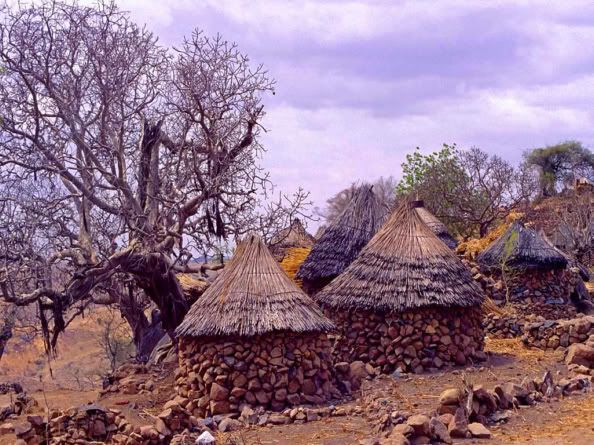
|
|
|

|
|
|
#4 |
|
Arms Historian
Join Date: Dec 2004
Location: Route 66
Posts: 10,742
|
Hi Tim,
Very nice piece! This is quite a revelation to me, I have honestly never seen a takouba like this before, and was not aware of takoubas in Nigerian/Cameroon regions. I do know that the unusual hilt wth peak type pommel is seen on daggers in those regions. The blade with raised median ridge is quite contrary to known takouba blades, typically simple broadsword with triple central fullers, or obviously broadsword variants. Also, why do they wear a 33 inch bladed sword on the arm? I know of course of the Tuareg and other arm daggers but they seem a lot smaller. All best regards, Jim |
|
|

|
|
|
#5 |
|
Member
Join Date: Dec 2004
Location: What is still UK
Posts: 5,939
|
It is really quite fascinating Jim and has got me thinking about the spread of straight "sabre" like blades across West Africa "Soudanic Africa West to East or vise versa" and down the East of Central Africa "Shi" Congo Rwanda and even Massai and others. A big area, a big question could be a big debate but would need many contributions?
|
|
|

|
|
|
#6 | |
|
(deceased)
Join Date: Dec 2004
Location: Portugal
Posts: 9,694
|
Hi David
Quote:
 We usually hear that a picture is worth a thousand words. In this case, a (Tim's ) word is worth a thousand pictures  Amazing nice piece Fernando |
|
|
|

|
|
|
#7 |
|
(deceased)
Join Date: Feb 2005
Location: Centerville, Kansas
Posts: 2,196
|
Welding on blade looks more like it was gas welded with a piece of high carbon rod (possible an old coat hanger?) than arc welded to me. I really know nothing of this type of weapon but I like the overall appearance of this. Nice score.
Robert |
|
|

|
|
|
#8 |
|
Arms Historian
Join Date: Dec 2004
Location: Route 66
Posts: 10,742
|
Hi Tim,
I've really been intrigued by this piece and have gone through as much as I can find on Cameroon weapons. Its been a truly fascinating adventure! From what I can find in previous posts and threads, there are indeed arm daggers somewhat similar to this that you noted were South Saharan, and in the weapons of Cameroon there seem to be wide variations. Going by what I have read, I would presume your piece might be a tebu/tabu hilt mounted with a sword blade, therefore an arm dagger hilt. Naturally I dont think this would be worn on the arm with a 33" blade, but the reworked scabbard retains its arm loop. The blade and wrapwork on the hilt to me suggest possibly Bali tribal group, but I am uncertain if that would concur with the Mandara attribution you note. The debate on the diffusion of weapon forms and blades throughout Africa has been going on for a very long time. The key to most of this is to focus on trade route networks, colonial incursion and nomadic movement /interaction. It is really not unusual to see weapons vast distances from thier origins in Africa, and I've always enjoyed the challenge of trying to trace some of these movements. Very nice acquisition Tim! and a great study piece!!!  All best regards, Jim |
|
|

|
|
|
#9 |
|
Member
Join Date: Dec 2004
Location: What is still UK
Posts: 5,939
|
The Mandara region may be quite sizable and could be home to a couple of related peoples. If I put my hand through the arm loop I might not get it off again so I will get my wife to model it. I can see no reason why it could not be worn on the inside of the forearm hilt to the hand. I will try and get magnified day light pictures of the weld so one can see the slag affected metal.
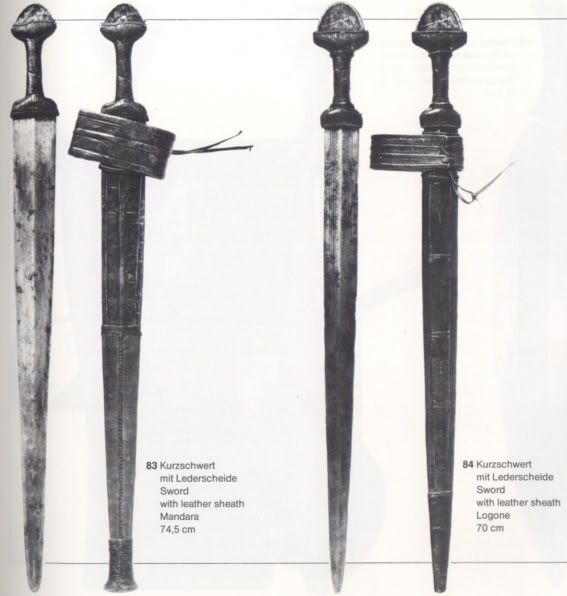
|
|
|

|
|
|
#10 |
|
Member
Join Date: Dec 2004
Location: What is still UK
Posts: 5,939
|
I am not really that knowledgeable about welding having only done a small amount of gas welding. However as you can see from these magnified day light pictures this weld is quite delicate work and one can see there was never a complete brake. The weld and forging of the blade have been done at the same time. One side shows more layering of the metal. It is clear that slag was a problem. Also arc welding would not fit the age of the handle. I have never seen arc welding not burn the surrounding area. Arc welding became widely used in the 1920s so I doubt available in the backwoods of Africa, possibly Oxyacetylene in cities. The weld is not all scabby like the flash pictures make out.
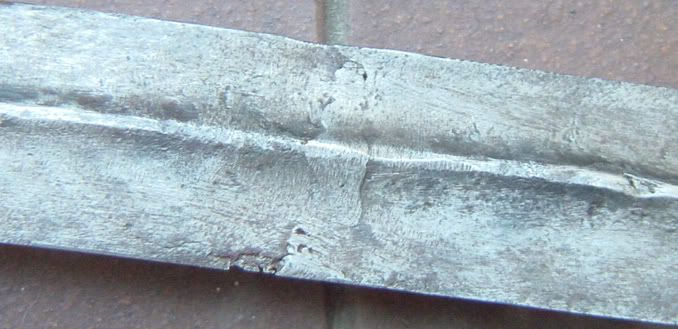 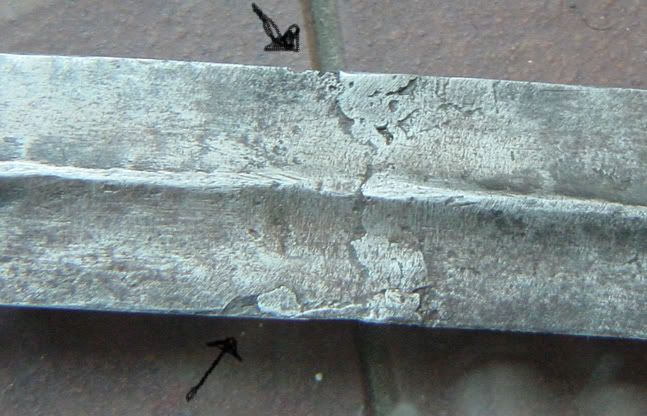 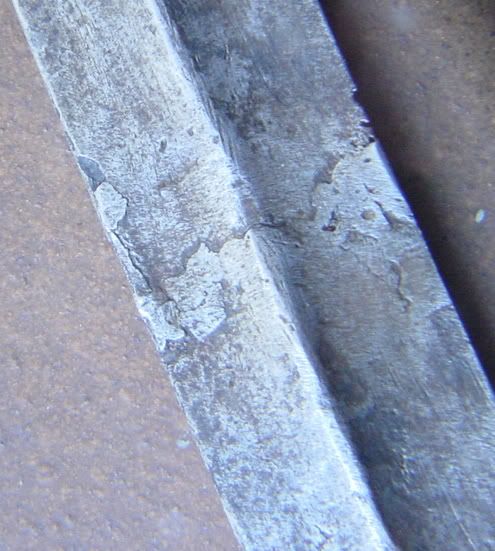 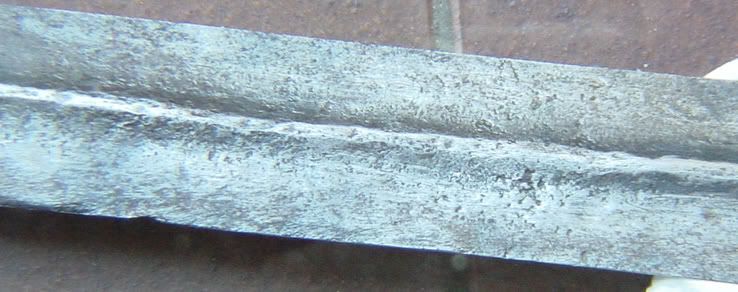 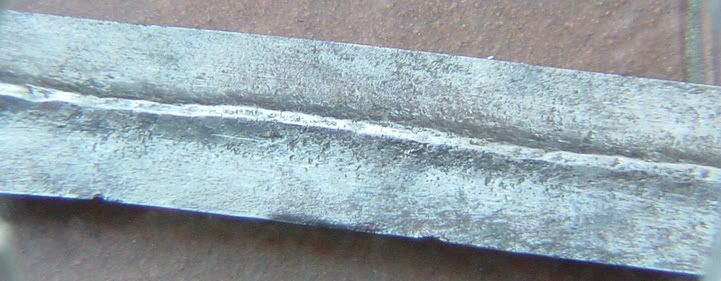
Last edited by Tim Simmons; 12th December 2007 at 08:04 PM. |
|
|

|
|
|
#11 |
|
Member
Join Date: Dec 2004
Location: What is still UK
Posts: 5,939
|
On the person.
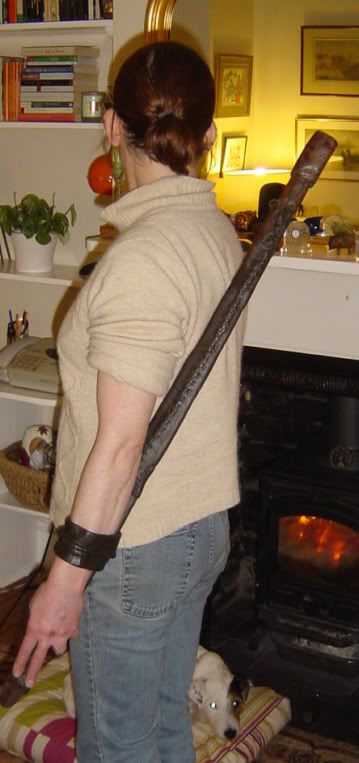
|
|
|

|
|
|
#12 | |
|
(deceased)
Join Date: Dec 2004
Location: East Coast USA
Posts: 3,191
|
Quote:
Cute doggy is it a Jack Russell terrier? Lew |
|
|
|

|
|
|
#13 |
|
Member
Join Date: Dec 2004
Posts: 1,247
|
So...can your wife actually draw the sword when it's on her arm?
|
|
|

|
|
|
#14 | |
|
Member
Join Date: Jan 2006
Location: Kent
Posts: 2,658
|
Quote:
Hi Tim I was thinking more along the lines that... if welded it was much later than when forged, (later damage repair?) A forge weld would only require (in this instance) two pieces of steel/iron (the 2 halves of the blade), AFAIK the correct heat, flux and hammering would create an almost seamless joint. The join in your pictures (the 'raised' seam) suggests that a third 'piece' of steel/iron was added ie from an arc welding rod or, if gas welded, some 'donor' steel/iron (for instance the 'coat hanger wire' suggested by Robert) With my very basic knowledge of the forging process, I thought that... If the blade had been damaged / broken then to facillitate a forge weld the handle would have been removed. The two halves (of the blade) would have then been heated to a high temperature and cooled very slowly (to normalise and relieve stresses within the metal structure) this would remove the temper and 'hardness'. Then the two halves would have been forged welded (heat/hammer work), and once done, shaped. It is likely that the whole blade would again be heated to a high temperature and very slowly cooled ....to again remove stresses in the metal's structure (sometimes done several times). Finally the whole blade would heated to the correct heat/colour and quenched to give the blade its final hardness/temper. Any how, whether I'm right or wrong.... it is still a good piece. Showing how it was worn brings the 'sword to life'. Kind Regards David |
|
|
|

|
|
|
#15 |
|
(deceased)
Join Date: Dec 2004
Location: Portugal
Posts: 9,694
|
Not forgetting the dog
 What's his name ? |
|
|

|
|
|
#16 |
|
Arms Historian
Join Date: Dec 2004
Location: Route 66
Posts: 10,742
|
Hi Tim,
Thank you so much for displaying the reference which shows this weapon is indeed Mandala, which reference is it? It's funny, I've always added references and page numbers etc. in my posts as a matter of habit, as well as very academic colleagues who emphasized the importance of adding such supporting information. Working without my resources at hand I rely very much on past posted material in the archives, and the few resources I typically have with me. In any case this was good exercise in trying to identify this sword, and I appreciate this reference now added to my notes. The common goal I share with the staff and many of the members here is virtually building a resource network that we can all share in researching and learning about these weapons. In the time I spent reviewing posts to try to confirm the identification of this sword, I must say your contributions have been key to the core of knowledge here on African weapons, along with of course Freddy, Lew and many of the others who have added vital observations. Now that I know this weapon is from Mandala, I also now see how such a long weapon was worn (very nicely shown ! and please thank your wife for her kind assistance). Nicely done Tim! All the best, Jim |
|
|

|
|
|
#17 |
|
Member
Join Date: Dec 2004
Location: What is still UK
Posts: 5,939
|
The sword can be drawn when the arm is moved so that the elbow is pointing straight out behind the body.
In forge welding more than two pieces of metal can be joined. Metal can be introduced to the work. In the sword you can see that for the environment and one just has to study the materials of the piece, I would say this was the work of a highly skilled smith an artist no-less. The dog is called "Patch" he is a "Parson Russell" He works as a PAT dog -Pets As Therapy. They are hard to train, lively with a very strong hunting instinct he is always ready to fight. He is neutered and muzzled when let free, glad I am not a dog. I would not recommend then even if he is sweet and loving to people. Forgot to mention the pictures are from "Waffen aus Zentral-Afrika" a simply most have book. They come up quite frequently on Belgian ebay so watch out for a copy. Thanks for all the interest, I received the club I mentioned at the start of the thread. I am saving it to post on Christmas day for relaxation when mother inlaw has gone home  . .
Last edited by Tim Simmons; 13th December 2007 at 10:30 AM. |
|
|

|
|
|
#18 |
|
Member
Join Date: Nov 2005
Posts: 189
|
As a swordsmith with extensive forgewelding experience who has shared shop space with welders and architectural blacksmiths, I’d have to say the discontinuity in the metal of this blade appears to be completely consistent with an arc/gas weld done long after the forging of the blade.
It would be impossible to get the metal to look that way via a forge welding process. That’s what the photos are saying, but of course I defer judgment to those who can see the actual sword. 
|
|
|

|
|
|
#19 |
|
Arms Historian
Join Date: Dec 2004
Location: Route 66
Posts: 10,742
|
Thank you Tim!
|
|
|

|
|
|
#20 |
|
Member
Join Date: Dec 2004
Location: What is still UK
Posts: 5,939
|
It is probably best to have an open verdict on the weld. In my opinion it was done at the time of and in the forging of the blade. My reasons are-
The lack of any burn at the site, bluing or straw discolouration . There is only the most basic finishing to the metal. A new weld on any piece of metal would make rather a lot of mess. Even a high tech spot weld leaves a blue halo. You can see in the pictures thin metal layers are worked and spread by hammer action. I have some other African pieces I will get day light pictures of to make comparisons with. Finally and not wanting to be rude to anyone. Perhaps the work is skilled and delicate beyond the average metalworker particularly when they are really only used to working in a western environment with plentiful western materials. Would such a large later added weld not affect the temper? The temper is even through the blade. Last edited by Tim Simmons; 13th December 2007 at 08:22 PM. Reason: spelling |
|
|

|
|
|
#21 |
|
Member
Join Date: Dec 2004
Location: What is still UK
Posts: 5,939
|
look at these neat little gas welds. There are places around the sword weld that have not been cleaned. There does not seem to be any signs of the latter application of massive heat.
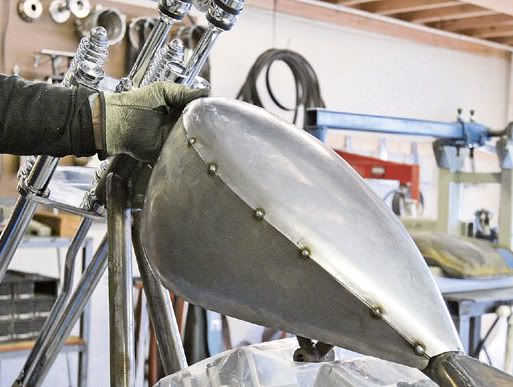 I bet this chap thinks he is a really smart dude. He probably wares boots and gloves, and has a work bench! |
|
|

|
|
|
#22 |
|
Member
Join Date: Jan 2006
Location: Kent
Posts: 2,658
|
Hi Tim,
the small neat welds on the bike tank are tack welds, to hold its 'structure' before the final welded seam. If the blade was indeed arc/gas welded, it could easily be done in small increments leaving the blade to cool 'between' welds. This would limit heat transference (by convection) to the surrounding blade. The heat with welding tends to be 'localised' to the immediate area (dependent on duration of welding, thickness of metal, etc) Also I have found a technique whereby the 'hot' weld is hammered to limit welding distortion. If this technique was used on this blade ...it could explain the confusion. "....Welding Distortion Welding Distortion is caused by the localised heat that welding creates along with shrinking of the weld metal as the weld cools. It is difficult to avoid welding distortion but a few simple steps will help minimise the problem. If possible plan the job to avoid long welding runs. If long welding runs are unavoidable use plenty of tacks, weld with the welder turned as low as possible and do a series of short welding runs, allowing the workpiece to cool between welding runs. Using backing plates to help take welding heat away will also help. Welding Distortion can be corrected from butt and outside corner welds by peening. Do this by holding a metal block behind the weld and peening evenly along the weld with a hammer. This process stretches the weld metal to correct the shrinking that occurred during cooling. Avoid over peening as this will overstretch the weld and re-distort the workpiece....." http://www.thewelderswarehouse.com/welding.html Kind Regards David |
|
|

|
|
|
#23 |
|
Member
Join Date: Dec 2004
Location: What is still UK
Posts: 5,939
|
David that is very helpful.
I just have the feeling that there is a certain lack of understanding about the the source, value and quality of the materials involved. The difficulties they presented I think we do not understand. It is clear to see the sword is not made from the finest trade steel. To look at working this valuable material as if it were common place and easily affordable is blinding us to the skill and determination needed to create the sword. It is easy today to make swords when you can buy very good steel to work and play with. If you have a bad batch of steel "unlikely" you would just send it back. I would suggest the sword in question was a struggle to make presentable to the client. You have to admit there are no signs of heat distress. The fellow that made this probably only had a rag covering his privates. Worked on his haunches without boots or gloves and swore like a trooper at the boys he had helping as it was becoming harder and harder to finish. |
|
|

|
|
|
#24 | ||
|
Member
Join Date: Nov 2005
Posts: 189
|
Quote:
 – – The discoloration around weld zones is an oxide layer on the surface of the metal. It is measured in angstroms, usually several hundred to a few thousand. Wavelengths of light are also measured in angstroms, they are used for very tiny things. The discoloration can be removed from steel by rubbing with dirt (the traditional method used throughout history, around the world) and it does not take long, or affect the surface of the steel to any significant degree. Skilled forgewelds (and arcwelds, for that matter) even in very primitive cultures can only be detected by polishing and etching the surface, or by x-ray. Temper would be affected by a later weld, but how did you test your blade to determine the uniformity of the temper? Quote:
 ), I could go on for hours about how valuable that hard-won steel is, compared to store-bought stuff that comes in convenient ready-to-forge sizes and all. ), I could go on for hours about how valuable that hard-won steel is, compared to store-bought stuff that comes in convenient ready-to-forge sizes and all. 
|
||
|
|

|
|
|
#25 | |
|
Member
Join Date: Jan 2006
Location: Kent
Posts: 2,658
|
Quote:
Hi Tim, I really did not want to labour the point. You have acquired an interesting sword  Which I had 'dismissed' as possibly 'Tebu' or neighbouring regions Which I had 'dismissed' as possibly 'Tebu' or neighbouring regions  and I feel that unfortunately the 'weld' has taken up more of this thread that it should. I would prefer to talk about the sword and the swords social and historical context. and I feel that unfortunately the 'weld' has taken up more of this thread that it should. I would prefer to talk about the sword and the swords social and historical context. Intriqued by the possibillity of forging techniques used in Africa that were not known, as you seemed to have suggested. I did a little research, sorry Tim but the Mandara region has been involved in Iron smelting and 'smithing' for centuries. The skill of the metal workers was well known. "...... Iron is found in abundance in all the Mandara hills. All the houses, or huts, at Mandara hare outer doors to the court, which are made of pieces of wood, hasped together with iron. They make hinges, small bars, and a sort of hoe, used to weed the corn, and send them for sale to the Bornou towns ...." A System of Geography, Popular and Scientific: Or A Physical, Political, and ... By James Bell Published 1832 Early Iron Age sites (2,600-1,900 BC) In west and central Africa, iron working developed in the Mandara Mountains, on the borders of Nigeria and the Cameroon, and in the area around Yaoundé in the south of Cameroon around 2,600 BC. http://66.102.9.104/search?q=cache:h...nk&cd=49&gl=uk I also believe that the sword was most likely made as a functional weapon. During the 'slavery' period ....other tribes commonly raided the Mandara hill areas to capture slaves and take other commodities. Weapons to protect themselves is mention in a number of resources. Regards David |
|
|
|

|
|
|
#26 |
|
Member
Join Date: Dec 2004
Location: What is still UK
Posts: 5,939
|
Thanks for the excellent replays.
David I did not want to suggest that smelting or iron work was rare. I was just trying to suggest and I think successfully the difficulties of working this locally smelted iron of a standard one would not come across today. Also smithing techniques that may be of an artistic nature not often encountered. I have only tested the sword by bending from end to end to stress the middle more or less were the weld is. This is not scientific I know but I can say I have done this with my heart thumping with fear. I have taken this bending to the point where if I were to bend it out of shape it would happen about 1-2 inches below the weld and after all I do not want to damage it. It almost seems as if the weld is actually harder? stronger? I am not just saying this for affect, it flexed more than I expected better than other weapons I have not just from Africa. So I cannot see the weld as an after thought. An overall observation of the sword and the scabbard in particular with a chape made of an old boot. Are surely indicators of an origin far from wealth and cosmopolitan tastes. I feel sure by the fact that it is not trade steel, this has to be made at the turn of the 19th century certainly no latter than 1930. I could not say when trade steel replaced local smelting but I would have thought 1930 was very late in this matter. Gas could be a possibility but would appear too urbane? I need to show more day light pictures of the whole thing again. Thanks for all your replays. Last edited by Tim Simmons; 14th December 2007 at 07:45 PM. |
|
|

|
|
|
#27 |
|
Member
Join Date: Dec 2004
Location: What is still UK
Posts: 5,939
|
This could put the tin hat on it. Life's a gas
 possibly. possibly.Seriously one does not always understand the pace of change. People live in communities without education, electricity, sanitation and a medieval mindset but have cell phones. http://www.weldingmag.com/323/Issue/...se/45962/Issue I will sort out some nice pics over the weekend |
|
|

|
|
|
#28 |
|
Member
Join Date: Dec 2004
Location: What is still UK
Posts: 5,939
|
The weld factor probably put people off. I am now even more sure I got a bargain.
|
|
|

|
|
|
#29 |
|
Member
Join Date: Dec 2004
Location: What is still UK
Posts: 5,939
|
Some daylight pictures. The midrib is 7mm at the forte and is an average of 6mm to the tip. So it is very business like and one heck of a weld which I imagine has been work in the forging, that may be why there are areas looking like hammer spread thin metal.
Learning all the time. Thanks. 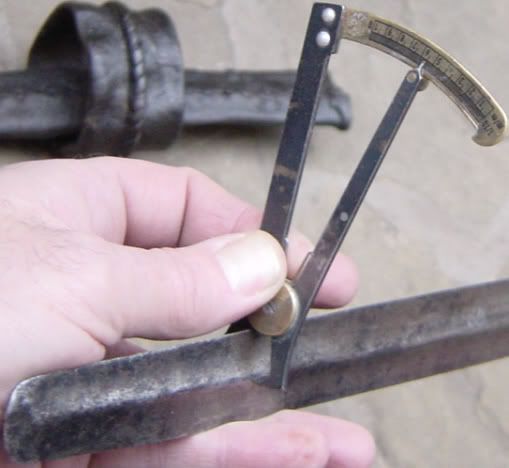   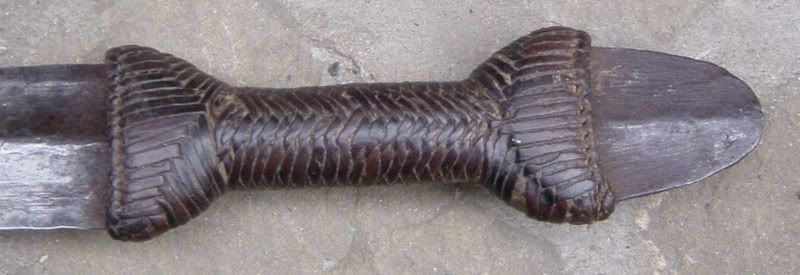 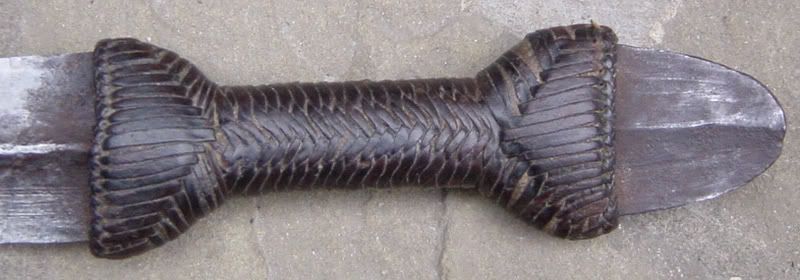  
Last edited by Tim Simmons; 15th December 2007 at 12:10 PM. |
|
|

|
|
|
#30 |
|
Member
Join Date: Jan 2006
Location: Kent
Posts: 2,658
|
Reading some more about the Mandara Hills I have found that many tribes relocated there due to the iron ore deposits. Either as smelters or smiths, almost a 'Solingen of Africa', although weapons were not their 'exclusive' wares.
Because of the numbers of differing tribes that inhabited the Mandara Hills, that smelted the iron and 'worked' the metal. Fortifications were built as the population increased. The smelting technology used was more advanced than many other areas of Africa. I get the impression that the smelted iron was of good quality and 'in demand' from neighbouring tribes whom would either trade for it ......or 'raid' for it. Also, as mentioned before, Mandara was often 'plundered' for slaves. A 'slideshow' of some excavated fortifications, use the 'top' arrow to see the next pic.....and so on. http://www.mandaras.info/StrongholdsNCameroon/fv1.htm Regards David As a footnote ... AFAIK weapon forms in Africa have been said to have 'spread' via trade routes and conflict. It is quite likely that in an area such as Mandara the 'intermingling' of tribal smiths also created an 'intermingling' of ideas and weapon forms, as well. Last edited by katana; 15th December 2007 at 05:06 PM. |
|
|

|
 |
|
|